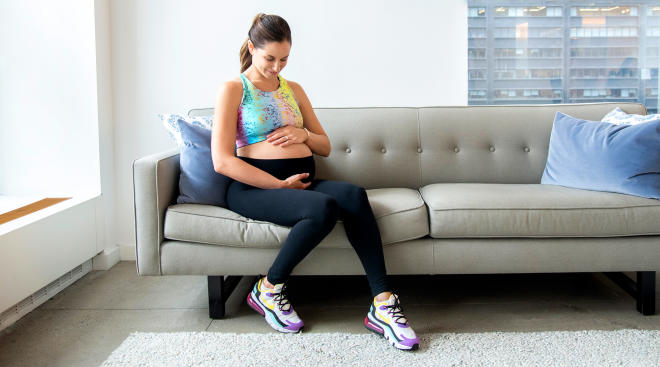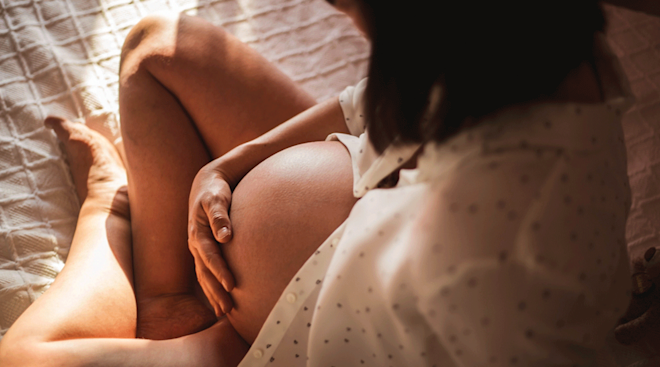The Benefits and Risks of Trying Nipple Stimulation to Induce Labor
Inching toward the end of your pregnancy and eager to meet baby? You’re not alone. Many moms-to-be and pregnant people search for ways to naturally induce labor as they approach their due dates. One of the most common (and medically researched) option involves nipple stimulation to induce labor. But when should you try it and how? And just how safe is nipple stimulation for inducing labor and starting contractions? Here, prenatal experts answer all your questions.
First things first: How would nipple stimulation induce labor? According to Meleen Chuang, MD, an ob-gyn and medical director of women’s health at the Family Health Centers at NYU Langone, it helps to promote the release of oxytocin, the hormone that stimulates the uterus and causes contractions. (In fact, providers use a synthetic version of oxytocin, Pitocin, to medically induce labor when necessary.) Oxytocin is also the hormone that promotes milk let down, and it’s released into the body when breastfeeding or pumping, adds Rebekah Mustaleski, CPM-TN, a certified professional midwife and compression director with Motif Medical.
So can nipple stimulation induce labor in reality? Some studies have found it can be effective, but more research is needed. “Nipple stimulation can induce labor, but it requires your body to be ready to go into labor,” Mustaleski explains. Labor is a complex biological process that involves a signal sent from baby’s body to yours, as well as hormonal stimulation. Essentially, if your body is ready to go to labor, nipple stimulation can help start contractions, but if it’s not, it won’t do much to help.
According to Chuang, it’s generally safe to try nipple stimulation to start contractions and induce labor, especially if your pregnancy is low-risk and at full-term. But experts emphasize getting the green light from your provider before trying this method, as there are certain situations in which trying nipple stimulation for inducing labor may not be safe. Chuang cites says that if you’ve had three or more C-sections, if baby is in a breech position or if you have placental abnormalities such as placenta previa.
Wondering how to induce labor using nipple stimulation? Chuang explains you can stimulate manually with your hands by gently rolling your nipple between your fingers for approximately 15 minutes at a time. You can also gently massage the areolas, which is the darker skin around the nipple, adds Alejandra Lucatero, LCSW, a licensed social worker who specializes in sexual health at the Hawaii Center for Sexual and Relationship Health in Honolulu. “The goal is to imitate the latch of a breastfeeding baby. You can use a breast pump, your hands or even your partner’s mouth on direct skin or thin clothing,” she adds. If you start to feel contractions, keep track of how frequently they occur and stop once they’re five minutes apart.
Mustaleski recommends using a double electric breast pump. “Every provider has their own preference, but I have my clients pump on both sides for 10 minutes and then take a 10-minute break. Continue alternating 10 minutes of pumping with 10-minute breaks for a total of two hours or until contractions are strong and regular,” she says.
Like many other things relating to pregnancy, how long nipple stimulation can take to induce labor—let alone if it will work at all—will vary from woman to woman. According to one 2018 study, which looked at the effect of breast stimulation on labor induction, oxytocin levels were found to be at their highest on the third day after three days of breast and nipple stimulation. Plus, a third of the women in the trial went into labor within 72 hours of the stimulation.
“It really depends on how sensitive your uterus is to oxytocin. Some may experience contractions shortly after starting, or it could take days,” Chuang says.
Depending on your pregnancy and any complications you’re experiencing, nipple stimulation may not be safe for you. It may even increase the risk of preterm labor, Lucatero says. “It’s recommended to begin when pregnancy is low-risk and you’re at or past your due date.”
Aside from that, Mustaleski adds that any method for inducing labor yourself may set you up for a longer and more challenging labor experience. “Labor goes the best when you and baby decide when to get started,” she explains. “That’s not to say that there aren’t times when inducing labor is the best decision, but you could cause your water to break earlier in the process, you could create a dysfunctional labor pattern or baby could be in a non-optimal position.” In other words, always reach out to your provider before using nipple stimulation or any other labor induction method to assess if it’s right for you and baby.
Additionally, Chuang cautions against overdoing it, as “excessive nipple stimulation can lead to overly strong contractions or uterine hyperstimulation.” If you feel uncomfortable contractions, or if they’re fairly close together, it’s important to stop, she adds.
There are other ways to potentially induce labor yourself (some evidence based, others more anecdotal). Either way, you’ll want to get the all-clear from your provider before trying any of the following methods:
- Walking daily and exercising
- Getting acupuncture and acupressure
- Having sex
- Eating spicy food and dates
Frequently Asked Questions
Can breastfeeding an older baby or toddler cause preterm labor?
Breastfeeding an older child or toddler usually doesn’t cause preterm labor, Chuang notes. “This is a question you should discuss with your healthcare provider if you have any concerns, particularly if you notice that your child breastfeeding is increasing the duration and strength of your contractions,” Mustaleski adds.
Can nipple play throughout pregnancy cause preterm labor?
The experts note that nipple play throughout pregnancy can be safe, especially earlier in pregnancy, but you should still exercise caution. “Some may experience increased sensitivity or contractions” with nipple play, Chuang notes, in which case it could cause preterm labor, Mustaleski adds.
Remember, not all natural induction methods—including nipple stimulation—work all the time—only when your body is ready,” Mustaleski says. “Even Pitocin doesn’t work all the time—it works best when the body is more favorable for labor.” It’s a long road to labor, but hang in there, you’ll be meeting baby very soon now!
Please note: The Bump and the materials and information it contains are not intended to, and do not constitute, medical or other health advice or diagnosis and should not be used as such. You should always consult with a qualified physician or health professional about your specific circumstances.
Plus, more from The Bump:
Meleen Chuang, MD, is an ob-gyn and medical director of women’s health at the Family Health Centers at NYU Langone, as well as the chief of obstetrics and gynecology at NYU Langone Hospital in Brooklyn, NY. She earned her medical degree from SUNY Stony Brook.
Alejandra Lucatero, LCSW, specializes in sexual health at the Hawaii Center for Sexual and Relationship Health in Honolulu, Hawaii. She has a background in trauma work and is certified in trauma-focused cognitive behavioral therapy and cognitive behavioral therapy training. She earned her undergraduate degree from University of California, Irvine and completed her master’s in social work at the University of Southern California.
Rebekah Mustaleski, CPM-TN, IBCLC, is a certified professional midwife specializing in evidence-based maternity care. She co-founded Roots & Wings Midwifery in Knoxville, Tennessee. Mustaleski received her bachelor’s degree in psychology from Centre College and worked as a doula and birth photographer prior to establishing Roots & Wings.
Yale Medicine, The Stimulation To Induce Mothers Study (STIM), July 2024
Cochrane Library, Breast stimulation for cervical ripening and induction of labour, July 2005
Plos One, Effects of breast stimulation for spontaneous onset of labor on salivary oxytocin levels in low-risk pregnant women: A feasibility study, February 2018
Learn how we ensure the accuracy of our content through our editorial and medical review process.
Navigate forward to interact with the calendar and select a date. Press the question mark key to get the keyboard shortcuts for changing dates.





















































